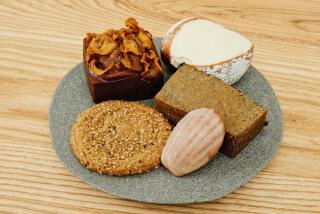Rice May Be Nice, but Here, Mochi Is Magic
If you thought steamed white rice was bland, maybe even excruciatingly boring, now is the time to think again.
Meet Mr. Mochi and think of ways to torture him to death, or challenge your wits on “The Rice Is Right,” or spend most of a sunny Saturday steaming, pounding and patting some 200 pounds of the stuff, all in the name of Japanese tradition and a lot of good family fun.
For all of the above you must first meet Tok Kataoka, a second-generation Japanese-American, or Nisei , who lives in La Habra.
This is Kataoka’s show, begun 40 years ago, when, as a 23-year-old returning war veteran, he realized that the ancient Japanese art of mochitsuki , the process of making the sweet rice cakes known as mochi , seemed to be going the way of bathtub gin, silent films and newsreels in movie houses.
Although Kataoka says his mother usually gathered the family together to make mochi in time for New Year’s, when the Japanese traditionally eat the rice cakes, he says the time and labor involved just got to be too much trouble.
For one does not undertake mochitsuki lightly, or alone. Today machines do it. But as Kataoka’s wife and two children have long since learned, such machines have no place in their home.
“It’s just me,” Kataoka says. “I’m just an old-fashioned hardhead.”
Kataoka is a mochi purist, a man who seems to enjoy slaving over steaming kettles of rice and swears that he and his family and friends can tell the difference between hand- or machine-pounded mochi . Kataoka’s son Mike says it would be similar to kneading bread dough in a Cuisinart. Unthinkable.
So around this time every year since 1947, Kataoka has risen before dawn to begin the long process of transforming Japanese sweet rice into his beloved mochi . The evening before, he washes it and leaves it to soak overnight.
Next comes steaming it in a seyo , or Japanese kettle, that sits over a blackened pot of boiling water. For years, the heat came from chopped wood provided by nephew Jerry Kobayashi, but in a rather recent concession to technology, Kataoka today uses a propane stove.
Then the real sweating begins. The hot sticky rice is transferred quickly to a handmade granite bowl, or usu , where it is poked at by several people, each armed with a boh , or stick, walking around the bowl at a rather brisk pace.
After the poking comes the beating, done with a kine , a long-handled wood mallet that is wielded by one moch i maker while another quickly picks up the doughlike mass and slaps it back against the granite surface before the mallet comes crashing down again. This is not without its risks.
Four years ago, Kobayashi ended up with his hand broken in five places after the kine came crashing down on it.
Yet Kobayashi, 40, was back in position Saturday, grabbing ahold and letting go of the gooey rice at lightning speed.
“It’s tradition,” he explains. “Pain is only momentary.”
Nonetheless, the smashing of his hand changed the Kataokas’ mochi tradition a bit. No beer drinking until after the mochi process is complete, usually about 2 p.m.
After the beating, the rice mass must cool for a moment before yet another shift of mochi makers has at it. This all-female crew divides up the blob and forms it into patties on a wood table covered with potato starch. The mochi are formed, placed in cardboard boxes and left to air a bit.
And then everyone eats some mochi , has a few beers and goes home. Right?
Wrong.
Many of the 60-some people at the Kataokas’ home, a collection of relatives and friends who show up every year, don’t even like mochi . After the mochi making, they will enjoy a feast of everything, ranging from takeout sushi to meat loaf to clam chowder.
Mike Kataoka and his wife, Jeanne, who like the other non- Nisei here calls herself a “round-eye,” say they still have mochi in their freezer from two years ago. And, yes, they, like the others here, will take home even more mochi this time.
Tradition, that’s the word everyone was using. Kataoka calls it “the warm part” of all this.
“This really brings the family together,” he says. “Today, it’s hard to keep families together.”
So why not expand that tradition just a little further?
That’s where Mr. Mochi and “The Rice Is Right” come
into it.
Mr. Mochi , a knockoff of “Saturday Night Live’s” tortured clay man, Mr. Bill, was born four years ago in a video made by Doug Evans, 35, a friend of Mike Kataoka from high school. Mr. Mochi-- made of guess what?--has since died a thousand gruesome deaths. He has been thrown from a tree, used as a kickball, drowned in beer, shot with a needle, bitten by a dog, sat on and run over by a car--all recorded on film.
Jeanne Kataoka says this year Mr. Mochi may be thrown to a hamster.
One year Mr. Mochi did have his revenge when he turned into a killer, a bigger-than-life monster Mochi , and ate a few parents. But he was later brought down to size and stepped on.
Nearly all the mochi makers at the Kataokas’ on Saturday were wearing T-shirts picturing a little man who looked like the stereotype Chinese railroad worker. Except this little man was holding a boh and kine . “ Mochi Man, 40 years, 1947-1987” read the lettering.
Oh, and “The Rice Is Right”? Just another fun mochi innovation from Jeanne, Mike and Doug. They’ve recorded the one-of-a-kind game show to test the mochi makers after they’ve eaten. Did you know that the first Kataoka mochi mallet was made of eucalyptus? Or that the Kataokas only used 20 pounds of rice in 1947?
But some of the multiple choice answers--the wrong ones--get pretty raunchy, in the best tradition of adolescent humor. Surely if you pick those, scoring three or less, you really are a mochi moron.
More to Read
Eat your way across L.A.
Get our weekly Tasting Notes newsletter for reviews, news and more.
You may occasionally receive promotional content from the Los Angeles Times.










